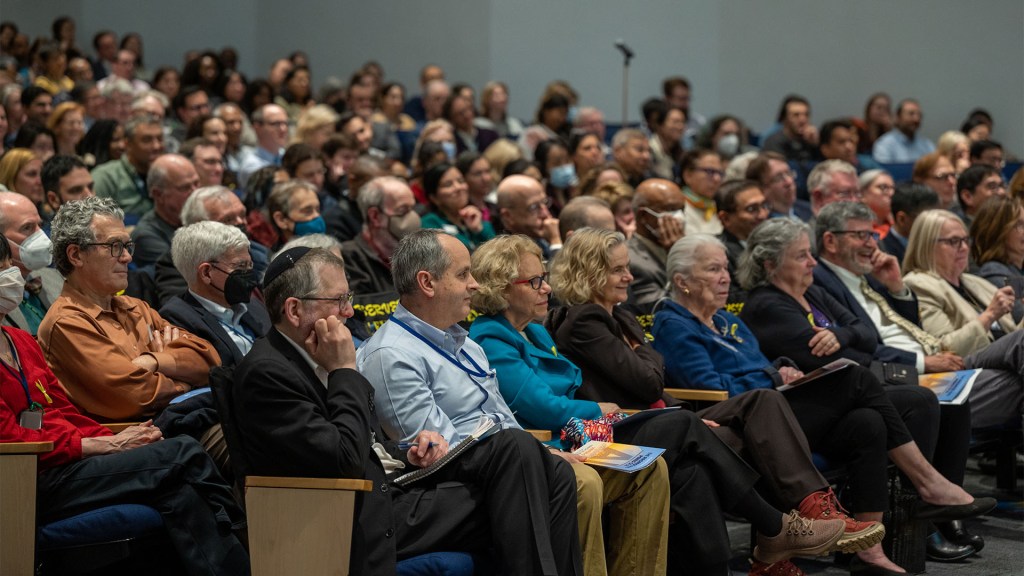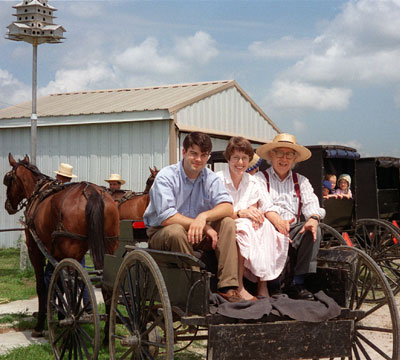Tribute
Welcoming Internet Pioneer Vint Cerf for Rall Cultural Lecture on AI in Biomedical Research
Posted on by Dr. Monica M. Bertagnolli

Last week it was my pleasure to welcome to NIH Vinton “Vint” Cerf, a pioneer of the digital world widely known as one of the “fathers of the internet,” to speak at our annual J. Edward Rall Cultural Lecture. We had a lively fireside chat focusing on “The Promises and Perils of AI in Biomedical Research and Health Care Delivery” that included discussions on topics like improving data collection, ensuring broad representativeness of the data being used to train AI and machine learning, expanding clinical research, and offering advice for scientists just starting out. It was an insightful, eye-opening conversation on a topic close to my heart. As NIH Director, I very much hope to deliver evidence-based health care to all people, and I’m excited about how AI and machine learning can help us advance toward that goal.
Dr. Cerf, who is vice president and Chief Internet Evangelist for Google, has too many awards to list, but just a few include the U.S. National Medal of Technology, the Turing Award, and the Presidential Medal of Freedom. He serves as an advisor to several government agencies, including the National Science Foundation, NASA, and the Departments of Defense, Energy, and Commerce.

The NIH Rall Cultural Lecture is held in honor of Dr. J. Edward Rall, who helped define the modern intramural research program at NIH. In the 1950s, he helped establish a stable, academic-minded, and culturally rich community within our rapidly expanding government agency. In 1984, he recommended that NIH add a cultural lecture to its Director’s Lecture series to enrich our scientific community.
As I said at the event, I’m grateful to Dr. Cerf for his visit and this conversation, and I can’t think of a more spectacular Rall Cultural Lecture than what he provided for all of us. You can watch the full talk here.

Celebrating New Clinical Center Exhibit for Nobel Laureate Dr. Harvey Alter
Posted on by Dr. Monica M. Bertagnolli

Earlier this month, I had the great honor of attending the opening of an exhibit at the NIH Clinical Center commemorating the distinguished career of Dr. Harvey Alter. Harvey’s collaborators, colleagues, and family members joined him to celebrate this display dedicated to his groundbreaking hepatitis C work developed by the Office of NIH History and Stetten Museum.
As I remarked at the event, we at NIH are proud to be able to claim Harvey as our own. He has spent almost the entirety of his professional career at the Clinical Center, working as a scientist in the Department of Transfusion Medicine since the 1960s.
Those who view this permanent exhibit will learn about how Harvey’s dedicated research has transformed the safety of the U.S. blood supply. Before the 1970s, nearly a third of patients who received multiple, lifesaving blood transfusions contracted hepatitis. Today, the risk of contracting hepatitis from a blood transfusion is essentially zero, thanks largely to Harvey’s research advances, including his work to identify the hepatitis C virus, which earned him the 2020 Nobel Prize in Physiology or Medicine. A cure for hepatitis C became available in 2014, and former NIH Director Dr. Francis Collins, who was at the event, has been working with President Biden to ensure greater access to these medications as part of an effort to eliminate hepatitis C in this country. This important work would not have been possible without Harvey’s foundational discoveries. Harvey is one of six Nobelists who did the entirety of their award-winning research at NIH as federal scientists, and the only NIH Nobel laureate to be recognized for clinical research.
This exhibit in the busy halls of the Clinical Center is a good reminder to the many who pass by of why we do what we do: It can take long hours and many years, but we can make a significant impact in clinical care when we try to understand the root causes of problems. Please stop by when you’re there to learn more about Harvey’s remarkable career.

A Tribute to Two Amazing Scientists
Posted on by Dr. Francis Collins

Caption: Sir John Sulston (left) and Stephen Hawking (right)
Credit: Jane Gitschier, PLoS; Paul Alers, NASA
Over the past couple of weeks, we’ve lost two legendary scientists who made major contributions to our world: Sir John Sulston and Stephen Hawking. Although they worked in very different areas of science—biology and physics—both have left us with an enduring legacy through their brilliant work that unlocked fundamental mysteries of life and the universe.
I had the privilege of working closely with John as part of the international Human Genome Project (HGP), a historic endeavor that successfully produced the first reference sequence of the human genetic blueprint nearly 15 years ago, in April 2003. As founding director of the Sanger Centre (now the Sanger Institute) in Cambridge, England, John oversaw the British contributions to this publicly funded effort. Throughout our many planning meetings and sometimes stormy weekly conference calls about progress of this intense and all-consuming enterprise, John stood out for his keen intellect and high ethical standards.
NIH Family Members Giving Back: Toben Nelson
Posted on by Dr. Francis Collins

Caption: Toben Nelson (back row, far left) celebrates with his Roseville Raiders after winning Gopher State Tournament of Champions.
Caption: Heather Hammond Nelson
What was Toben Nelson, a University of Minnesota epidemiologist who studies the health risks of alcohol abuse and obesity, doing this summer lugging around a heavy equipment bag after work? Giving back to his community. Nelson volunteered as a coach for the Roseville Raiders, a 13-year-old-and-under traveling baseball team that just wrapped up its season by winning the prestigious Gopher State Tournament of Champions in their age group.
In the fall, Nelson will gear up for hoops as the volunteer president of the Roseville Youth Basketball Association, which provides an opportunity for kids in this Minneapolis-St. Paul suburb to take part in organized sports. Nelson says volunteering grounds him as a scientist. It reminds him every single day that his NIH-supported research back at the office affects real lives and benefits real communities like his own.
NIH Family Members Giving Back: Kafui Dzirasa
Posted on by Dr. Francis Collins

Caption: Kafui Dzirasa (front center) with the current group of Meyerhoff Scholars at University of Maryland, Baltimore County.
Credit: Olubukola Abiona
Kafui Dzirasa keeps an open-door policy in his busy NIH-supported lab at Duke University, Durham, NC. If his trainees have a quick question or just need to discuss an upcoming experiment, they’re always welcome to pull up a chair. The donuts are on him.
But when trainees pop by his office and see he’s out for the day, they have a good idea of what it means. Dzirasa has most likely traveled up to his native Maryland to volunteer as a mentor for students in a college program that will be forever near and dear to him. It’s the Meyerhoff Scholars Program at the University of Maryland, Baltimore County (UMBC). Since its launch in 1988, this groundbreaking program has served as a needed pipeline to help increase diversity in the sciences—with more than 1,000 alumni, including Dzirasa, and 270 current students of all races.
NIH Family Members Giving Back: Diane Baker
Posted on by Dr. Francis Collins

Caption: My wife Diane inspired me and my staff to volunteer to make dinner for patients and their families at The Children’s Inn at NIH.
Credit: NIH Record
My blog usually celebrates biomedical advances made possible by NIH-supported research. But every August, I like to try something different and highlight an aspect of the scientific world that might not make headlines. This year, I’d like to take a moment to pay tribute to just a few of the many NIH family members around the country who, without pay or fanfare, freely give of themselves to make a difference in their communities.
I’d like to start by recognizing my wife Diane Baker, a genetic counselor who has always found time during her busy career to volunteer. When I was first being considered as NIH director, we had lots of kitchen table discussions about what it might mean for us as a couple. We decided to approach the position as a partnership. Diane immediately embraced the NIH community and, true to her giving spirit, now contributes to some wonderful charities that lend a welcome hand to patients and their loved ones who come to the NIH Clinical Center here in Bethesda, MD.
Merry Microscopy and a Happy New Technique!
Posted on by Dr. Francis Collins

Seasons Greetings! What looks like a humble wreath actually represents an awe-inspiring gift to biomedical research: a new imaging technique that adds a dash of color to the formerly black-and-white world of electron microscopy (EM). Here the technique is used to visualize the uptake of cell-penetrating peptides (red) by the fluid-filled vesicles (green) of the endosome (gray), a cellular compartment involved in molecular transport. Without the use of color to draw sharp contrasts between the various structures, such details would not be readily visible.
This innovative technique has its origins in a wonderful holiday story. In December 2003, Roger Tsien, a world-renowned researcher at the University of California, San Diego (UCSD), decided to give himself a special present. With the lab phones still and email traffic slow for the holidays, Tsien decided to take advantage of the peace and quiet to spend two weeks alone at the research bench, pursuing an intriguing, yet seemingly wacky, idea. He wanted to find a way to deposit ions of a rare earth metal, called lanthanum, directly into cells as the vital first step in creating a new imaging technique designed to infuse EM with some much-needed color. After the holidays, when the lab returned to its usual hustle and bustle, Tsien handed off his project to Stephen Adams, a research scientist in his lab, thereby setting in motion a nearly 13-year quest to perfect the colorful new mode of EM.
Talking Music and Science with Yo-Yo Ma
Posted on by Dr. Francis Collins
It’s not every day that an amateur guitar picker gets to play a duet with an internationally renowned classical cellist. But that was my thrill this week as I joined Yo-Yo Ma in a creative interpretation of the traditional song, “How Can I Keep from Singing?” Our short jam session capped off Mr. Ma’s appearance as this year’s J. Edward Rall Cultural Lecture.
The event, which counts The Dalai Lama, Maya Angelou, and Atul Gawande among its distinguished alumni, this year took the form of a conversation on the intersection of music and science—and earned a standing ovation from a packed house of researchers, patients, and staff here on the National Institutes of Health (NIH) campus in Bethesda, MD.
A Veterans Day Tribute
Posted on by Dr. Francis Collins
Today, we celebrate Veterans Day. On this special day, let us pause and salute all who have served and honor the tremendous sacrifices made by members of the U.S. armed forces and their families to preserve our freedom.
This occasion also gives us an opportunity to acknowledge the many important contributions of the veterans who are now working here at NIH. Currently, our agency employs about 1,000 veterans and is making a concerted effort to add even more to our ranks. As a result of these outreach and recruitment efforts, NIH hired 122 veterans during fiscal year 2014… 48 of whom were disabled veterans, I’m proud to report.


